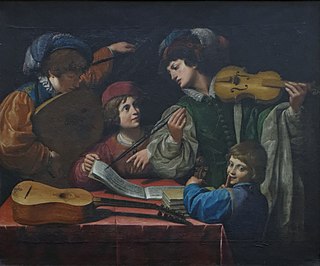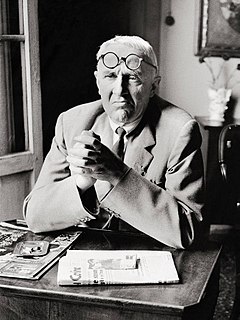
Cristoforo da Bologna was an Italian painter. He was active in Bologna, Modena, and Ferrara. He painted toward the close of the 14th and the beginning of the 15th century.

Cristoforo da Bologna was an Italian painter. He was active in Bologna, Modena, and Ferrara. He painted toward the close of the 14th and the beginning of the 15th century.
| Wikimedia Commons has media related to Cristoforo da Bologna . |

Agostino Carracci was an Italian painter, printmaker, tapestry designer, and art teacher. He was, together with his brother, Annibale Carracci, and cousin, Ludovico Carracci, one of the founders of the Accademia degli Incamminati in Bologna. This teaching academy promoted the Carracci emphasized drawing from life. It promoted progressive tendencies in art and was a reaction to the Mannerist distortion of anatomy and space. The academy helped propel painters of the School of Bologna to prominence.

Annibale Carracci was an Italian painter and instructor, active in Bologna and later in Rome. Along with his brother and cousin, Annibale was one of the progenitors, if not founders of a leading strand of the Baroque style, borrowing from styles from both north and south of their native city, and aspiring for a return to classical monumentality, but adding a more vital dynamism. Painters working under Annibale at the gallery of the Palazzo Farnese would be highly influential in Roman painting for decades.

Guido Reni was an Italian painter of the Baroque period, although his works showed a classical manner, similar to Simon Vouet, Nicolas Poussin, and Philippe de Champaigne. He painted primarily religious works, but also mythological and allegorical subjects. Active in Rome, Naples, and his native Bologna, he became the dominant figure in the Bolognese School that emerged under the influence of the Carracci.

LudovicoCarracci was an Italian, early-Baroque painter, etcher, and printmaker born in Bologna. His works are characterized by a strong mood invoked by broad gestures and flickering light that create spiritual emotion and are credited with reinvigorating Italian art, especially fresco art, which was subsumed with formalistic Mannerism. He died in Bologna in 1619.

Francesco Albani or Albano was an Italian Baroque painter who was active in Bologna (1591–1600), Rome (1600–1609), Bologna (1609), Viterbo (1609–1610), Bologna (1610), Rome (1610–1617), Bologna (1618–1660), Mantova (1621–1622), Roma (1623–1625) and Florence (1633).

Giacomo Cavedone (1577–1660) was an Italian Baroque painter of the Bolognese School.

Cento is a town and comune in the province of Ferrara, Emilia-Romagna, Italy.

Pellegrino Tibaldi, also known as Pellegrino di Tibaldo de Pellegrini, was an Italian mannerist architect, sculptor, and mural painter.

Giuseppe Maria Crespi, nicknamed Lo Spagnuolo, was an Italian late Baroque painter of the Bolognese School. His eclectic output includes religious paintings and portraits, but he is now most famous for his genre paintings.

Lavinia Fontana was a Bolognese Mannerist painter active in Bologna and Rome. She is best known for her successful portraiture, but also worked in the genres of mythology and religious painting. She was trained by her father Prospero Fontana who was a teacher at the School of Bologna. She is regarded as the first female career artist in Western Europe as she relied on commissions for her income. Her family relied on her career as a painter, and her husband served as her agent and raised their 11 children. She was perhaps the first woman artist to paint female nudes, but this is a topic of controversy among art historians.

Giovanni Antonio Burrini was a Bolognese painter of Late-Baroque or Rococo style. After an apprenticeship with Domenico Maria Canuti, he went to work under Lorenzo Pasinelli with fellow student, Giovanni Gioseffo dal Sole. He became an early friend and often close collaborator with Giuseppe Maria Crespi, with whom he shared a studio. He became a rival and competitor with Sebastiano Ricci. He painted in Turin for the Carignano family and Novellara. In 1709, he was one of the founding members of the Accademia Clementina in Bologna.

Alessandro Tiarini was an Italian Baroque painter of the Bolognese School.

Marcantonio Franceschini was an Italian painter of the Baroque period, active mostly in his native Bologna. He was the father and teacher of Giacomo Franceschini.

Leonello Spada was an Italian painter of the Baroque period, active in Rome and his native city of Bologna, where he became known as one of the followers of Caravaggio.

Filippo Scannabecchi, known as Lippo di Dalmasio, was an Italian painter from Bologna, a son of Dalmasio Scannabecchi.

The Galli-Bibiena family, or Galli da Bibiena, was a family of Italian artists of the 17th and 18th centuries, including:

Giorgio Morandi was an Italian painter and printmaker who specialized in still life. His paintings are noted for their tonal subtlety in depicting apparently simple subjects, which were limited mainly to vases, bottles, bowls, flowers and landscapes.

Bologna is the capital and largest city of the Emilia-Romagna region in Northern Italy. It is the seventh most populous city in Italy with about 400,000 inhabitants and 150 different nationalities. Its metropolitan area is home to more than 1,000,000 people. It is known as the Fat, Red, and the Learn'd City due to its rich cuisine, red Spanish tiled rooftops, left wing politics, and being home to the oldest university in the western world.

Giuseppe Maria Mazza was one of the leading sculptors of Bologna, Italy, in the late 17th and early 18th centuries. He was trained as a painter, but is best known for his fine sculptural work in terracotta and stucco.